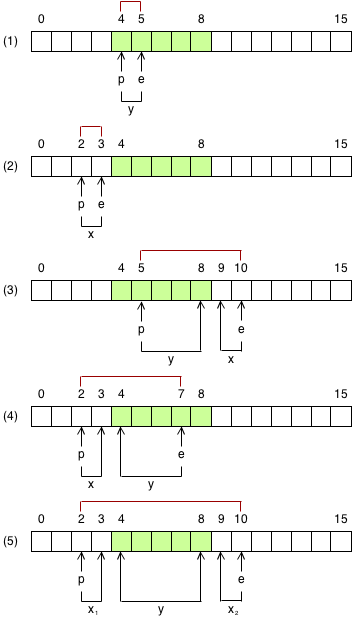
Research
/Security News
Contagious Interview Campaign Escalates With 67 Malicious npm Packages and New Malware Loader
North Korean threat actors deploy 67 malicious npm packages using the newly discovered XORIndex malware loader.
binary-reader
Advanced tools
This module is a wrapper around the fs.read() function. It has an internal buffer that maintains the last chunk of bytes read from disk, so it minimizes the number of I/O calls. If the requested bytes are already in the buffer it doesn't perform any I/O call and the bytes are copied directly from the internal buffer. It also implements a fluent interface for your ease, so it also tries to minimize the number of nested asynchronous calls.
Anything that needs to read big binary files to extract just a little portion of data, e.g. metadata readers: music, images, fonts, etc.
Benefits:
br.open(file).seek(50).close() does nothing.To make the things easier there are 5 cases depending on the buffer position and the range of the bytes that you want to read. These cases are only applicable if the buffer size is smaller than the file size, otherwise the whole file is read into memory, so only one I/O call is done.
Suppose a buffer size of 5 bytes (green background).
The pointer p is the cursor and it points to the first byte to read.
The pointer e is the end and it points to the last byte to read.
The x bytes are not in memory. They need to be read from disk.
The y bytes are already in memory. No need to read them again.
For the sake of simplicity, assume that the x group of bytes has a length smaller than the buffer size. The binary reader takes care of this and makes all the necessary calls to read all the bytes.

module.open(path[, options]) : Reader
Returns a new Reader. The reader is lazy so the file will be opened with the first read() call.
Options:
The reader uses a fluent interface. The way to go is to chain the operations synchronously and, after all, close the file. They will be executed in series and asynchronously. If any error occurs, an error event is fired, the pending tasks are cancelled and the file is automatically closed.
The read() and seek() functions receive a callback. This callback is executed when the current operation finishes and before the next one. If you need to stop executing the subsequent tasks because you've got an error or by any other reason, you must call to cancel(). You cannot call to close() because the task will be enqueued and what you need is to close the file immediately. For example:
br.open (file)
.on ("error", function (error){
console.error (error);
})
.on ("close", function (){
...
})
.read (1, function (bytesRead, buffer){
//The subsequent tasks are not executed
this.cancel ();
})
.read (1, function (){
//This is never executed
})
.close ();
Events
Methods
Arguments: none.
Emitted when the reader is closed or cancelled.
Arguments: error.
Emitted when an error occurs.
Reader#cancel([error]) : undefined
Stops the reader immediately, that is, this operation is not deferred, it cancels all the pending tasks and the file is automatically closed. If you pass an error, it will be forwarded to the error event instead of the emitting a close event.
This function is mostly used when you need to execute some arbitrary code, you get an error and therefore you need to close the reader.
br.open (file)
.on ("error", function (error){
console.error (error);
})
.on ("close", function (){
...
})
.read (1, function (bytesRead, buffer, cb){
var me = this;
asyncFn (function (error){
if (error){
//The error is forwarded to the "error" event
//No "close" event is emitted if you pass an error
me.cancel (error);
}else{
//Proceed with the next task
cb ();
}
});
})
.read (1, function (){
...
})
.close ();
Closes the reader.
This operation is deferred, it's enqueued in the list of pending tasks.
In the following example, the close operation is executed after the read operation, so the reader reads 1 byte and then closes the file.
br.open (file)
.on ("error", function (error){
console.error (error);
})
.on ("close", function (){
...
})
.read (1, function (){ ... })
.close ();
Checks whether the internal cursor has reached the end of the file. Subsequent reads return an empty buffer. This operation is not deferred, it's executed immediately.
In this example the cursor is moved to the last byte but it's still not at the end, it will be after the read.
var r = br.open (file)
.on ("error", function (error){
console.error (error);
})
.on ("close", function (){
...
})
.seek (0, { end: true }, function (){
console.log (r.isEOF ()); //false
})
.read (1, function (){
console.log (r.isEOF ()); //true
})
.close ();
Reader#read(bytes, callback) : Reader
Reads data and the cursor is automatically moved forwards. The callback receives three arguments: the number of bytes that has been read, the buffer with the raw data and a callback that's used to allow asynchronous operations between tasks. The buffer is not a view, it's a new instance, so you can modify the content without altering the internal buffer.
This operation is deferred, it's enqueued in the list of pending tasks.
For example:
br.open (file)
.on ("error", function (error){
console.error (error);
})
.on ("close", function (){
...
}))
.read (1, function (bytesRead, buffer, cb){
//Warning! If you use the "cb" argument you must call it or the reader
//will hang up
process.nextTick (cb);
})
.read (1, function (){ ... })
.close ();
Reader#seek(position[, whence][, callback]) : Reader
Moves the cursor along the file.
This operation is deferred, it's enqueued in the list of pending tasks.
The whence parameter it's used to tell the reader from where it must move the cursor, it's the reference point. It has 3 options: start, current, end.
For example, to move the cursor from the end:
seek (0, { start: true });
seek (0);
By default the cursor it's referenced from the start of the file.
To move the cursor from the current position:
seek (5, { current: true });
seek (-5, { current: true });
The cursor can be moved with positive and negative offsets.
To move the cursor from the end:
seek (3, { end: true });
This will move the cursor to the fourth byte from the end of the file.
Returns the size of the file. This operation is not deferred, it's executed immediately.
Returns the position of the cursor. This operation is not deferred, it's executed immediately.
br.open (file)
.on ("error", function (error){
console.error (error);
})
.on ("close", function (){
...
})
.seek (0, { end: true }, function (){
console.log (this.tell () === this.size () - 1); //true
})
.read (1, function (){
console.log (this.tell () === this.size ()); //true
console.log (this.isEOF ()); //true
})
.close ();
FAQs
Buffered binary reader with a fluent api
The npm package binary-reader receives a total of 24 weekly downloads. As such, binary-reader popularity was classified as not popular.
We found that binary-reader demonstrated a not healthy version release cadence and project activity because the last version was released a year ago. It has 1 open source maintainer collaborating on the project.
Did you know?

Socket for GitHub automatically highlights issues in each pull request and monitors the health of all your open source dependencies. Discover the contents of your packages and block harmful activity before you install or update your dependencies.

Research
/Security News
North Korean threat actors deploy 67 malicious npm packages using the newly discovered XORIndex malware loader.

Security News
Meet Socket at Black Hat & DEF CON 2025 for 1:1s, insider security talks at Allegiant Stadium, and a private dinner with top minds in software supply chain security.

Security News
CAI is a new open source AI framework that automates penetration testing tasks like scanning and exploitation up to 3,600× faster than humans.